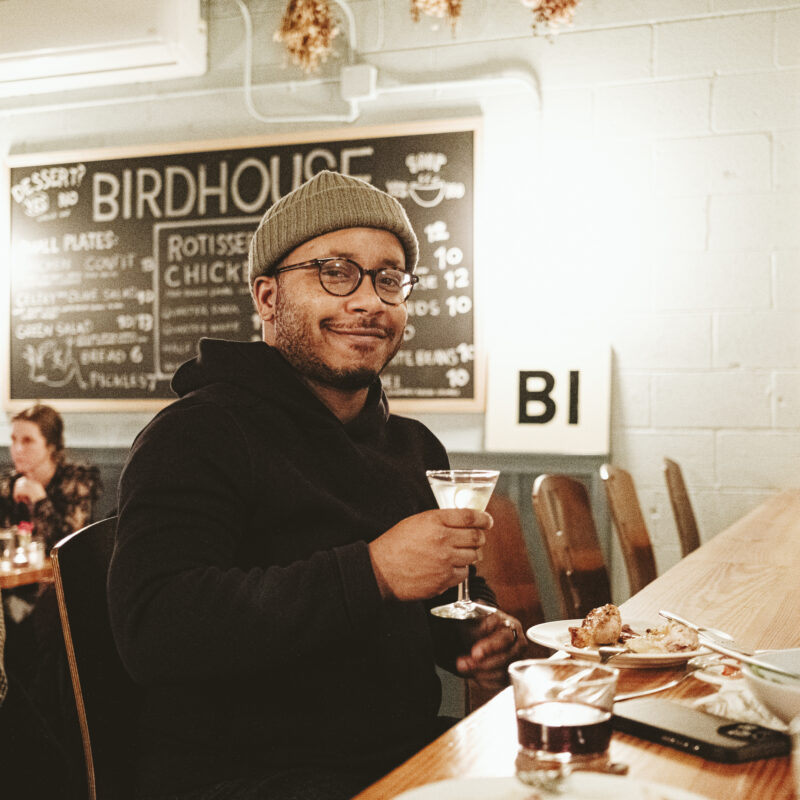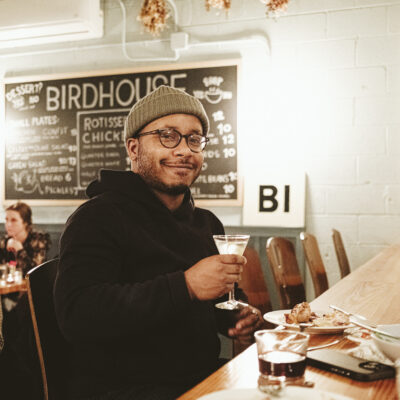Pole vault
Teacher surmounts her Mormon upbringing to teach burlesque – and other dance moves
The pole juts seven feet straight into the air from atop a 4’x4′ wood-and-ceramic-tile platform. A lithe, limber Brooke Shields lookalike in 5" heels, stockings and tight gym shorts and matching bra, swings suggestively around the brass fixture. She crooks one leg around it as the arch in her back grows deeper and the sultry bass notes of Alannah Myles’ “Black Velvet” roll through the atmosphere. Only one thought comes to mind: “What’s a nice Mormon girl doing in a position like this?”
For Nicole Huffman, who uses the stage name Nadia, the answer is “teaching.” The 26-year-old dancer and dance instructor, who relocated to Charlottesville four years ago, conducts hours of private and group lessons at Berkmar Ballroom each week. Pole dancing, or what she calls “efitdance” – as in exotic fitness dance – is simply her latest offering.
Okay, maybe “simply” is the wrong word. No matter how much she might protest that in years-ahead Europe and trend-loving California, pole dancing (as in Bada Bing! but with more clothes) is practically the new Pilates or step aerobics, Huffman still has to glide past the tittering. Past jokes about students getting a “night job,” or manly offers to lend an eager helping hand in the women-only class.
But she has a hard-won determination to practice and teach body awareness (what else is dance, anyway?), so she doesn’t get too gummed up in the heh-heh innuendo. Born as the only daughter in a family of four Idaho kids, Huffman knows well the inside of a Latter-Day Saints church and its mindset. Getting past a couple of “Man Show” jokes about stripping pales next to overcoming Mormonism.
“Dancing is my form of self-expression and release,” she says, describing herself as being less comfortable talking. “The girls in the class said the same thing – they’re shy and reserved. Let it out. If you keep so much inside, it’s not healthy.”
Burlesque is not actually in Huffman’s background (although she did perform with a Cirque du Soleil spin-off troupe), yet as a dancer for more than 20 years, she’s a natural at teaching pole routines. That’s because, as she puts it succinctly, there are only so many ways to move a set of hips. Anybody who has been teaching ballroom dance (as she has for four years locally), especially Latin-influenced dances, understands how to get the full orbital impact out of those joints.
To make her point, at the start of a recent class the by-day legal editor who moved here to earn a graduate degree in American studies shows students a four-minute routine (that’s where the throaty Myles comes in). Gliding from a corner of the 2,000-square-foot studio decorated with posters from such dance flicks as Tango Pasion and Shall We Dance? Huffman rolls her hips and bends her knees along the way. Eventually she gets on the pole, caressing it with her long legs confidently and with sass. Myles hits her last big note, and, demo over, Huffman gets on with business. It’s 11am, so to advance the five women in that day’s class, Huffman gets everyone to warm up. Stretches, heel-toe walks, hip rolls, hip rolls the other way, pivoting hip rolls – 30 minutes have elapsed before any student, most of whom are barefoot and outfitted in sweats, gets near a pole.
When at last they do, they discover it takes real strength to get up on it. Several of the students will clearly achieve victory when they can simply suspend themselves with two hands from the head of the pole for a dozen seconds. In the interest of improving, some will probably pay for private practice time in the studio as, for now, none have their own poles at home.
But even enrolling in the class, it turns out, takes a certain kind of strength. “My long-term goal is to swing around the pole, because it’s physically challenging,” says a 30-year-old student who, in fulfilling her first homework assignment from Huffman, chose the stage name Giselle. “But I didn’t tell my mother. She’s an old Catholic woman. I did say I’m taking a dance class, though.”
Natasha, another student with a theatrical alias, asserts more psychological goals: “To feel more comfortable with myself and my sexuality,” she says.
The way Berkmar Ballroom owner Steve Shergold sees it, any step toward “self-empowerment,” as he says, marks the right direction for his business. “Anyone who comes here for lessons, for pole dancing or social dancing, within three months, we’ll turn you into a different animal,” he promises.
“If it’s to do with dancing and self-expression and gets people connected,” he continues, “we want to be doing it.”
Not that anybody at the studio is dictating exactly how people might connect as a result of pole – or any other kind of – dancing.
“This class is not about stripping or nudity,” says Huffman. “It’s showing you moves to get more in touch with your body. What you do after that is up to you.” – Cathy Harding
Glad to be caught in the spokes
Blue Wheel Bicycle’s owners peddle success
Every morning, among the cadre of dedicated athletes who keep the dawn patrol, Scott Paisley and Roger Friend have a standing date with their bicycles. Each man rides alone. Paisley leaves the home he built for his wife and three children in Nelson County and pedals 30 miles to work. He has a long history of preferring this mode of transportation: 22 years ago Paisley and his wife, Marian, cycled through Europe on a tandem, stopping in London for the birth of their first child. Three months later they pushed off for Scandinavia, then Australia, Japan and New Zealand, baby Rachel installed in a backpack Paisley bolted to the rear handlebars. “It was a wonderful way to travel,” Paisley recalls. “People either looked at us like we were totally insane, or they invited us home for dinner.”
At 44, his commute remains a precious window of time in the open air. Neither rain nor darkness deters him. He lets his mind wander and, when he’s building up to a competition, he pushes himself. Paisley calls his approach to training “relatively unscientific.”
“The battery stopped working on my cycling computer six or seven years ago and I never replaced it,” he says.
Friend, 42, departs from the apartment he moved into 19 years ago when he started working at the bike shop downstairs, intently focused on the training program that he pays a professional to plot for him. For 32 weeks of the year, each ride is calculated to maximize his physical potential on the days he races. When bad weather intrudes, Friend spends up to four hours indoors on a stationary trainer, watching race videos as he cranks away.
His focus has paid off. This year Friend took first place in the Virginia State Master’s TimeTrial with the overall second-fastest time of the day and placed 10th among masters at the National Championships TimeTrial, garnering the title of 40+ Mid-Atlantic Road Race Champion.
These men ride different rides, they live different lives and their personalities could not be more distinct. Yet by 10am each day Paisley and Friend are rubbing elbows in the homey shop at the end of Elliewood Avenue, co-owners of Blue Wheel Bicycles. Between them, they’ve experienced the full gamut of what a bike can do, from cyclo-cross to criterium, to the benefit of their customers, it seems.
“You can’t know what real quality is until you’ve taken bicycles and cycling to the extreme,” says Ian Ayers, head of the UVA cycling team. “Blue Wheel’s work is inspired by a true appreciation of performance. To Scott and Roger it’s a matter of love and pride.”
After years of toiling in obscurity, offering the personal attention of an independent retailer while losing sales to the discount chains, Blue Wheel Bicycles has been named “One of Nine Best Bicycle Shops in the South” by Unlimited: Action, Adventure and Good Times magazine. Its banner year continues at White Hall Vineyards on Sunday, October 26, with a celebration of the shop’s 30-year milestone, complete with road and mountain bike rides and birthday cake.
Looking back, Friend may wince at his youthful conviction that “owning a bike store was more fun than going to law school,” but he will concede “there are worse things to be involved in, in terms of world karma. I’m not making bombs.” Paisley values the “wonderful surprises” that come through the door every day: “remarkable athletes, funny peopleit’s like little short stories going on all the time.” – Phoebe Frosch





